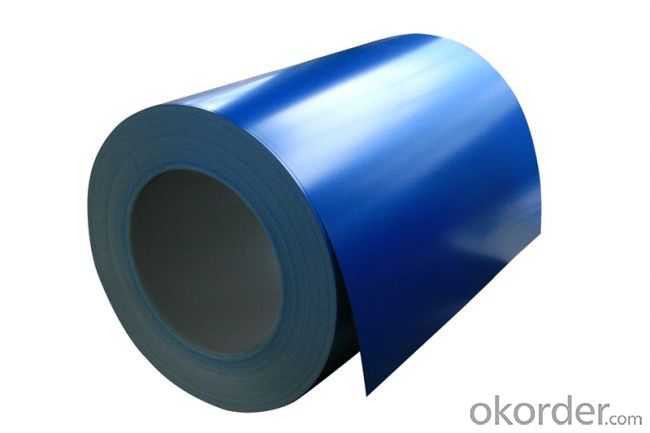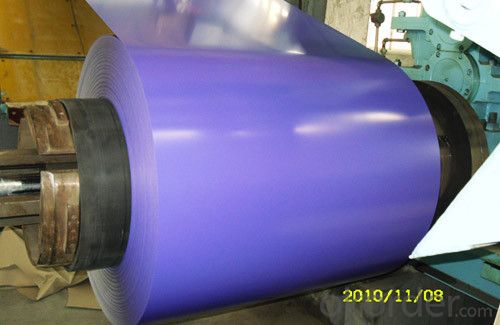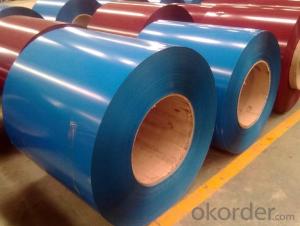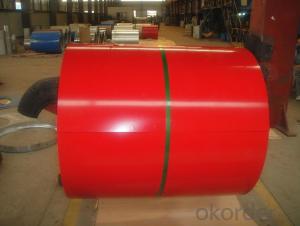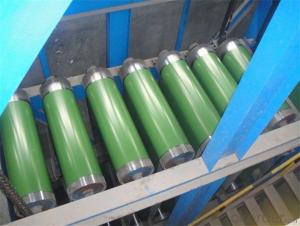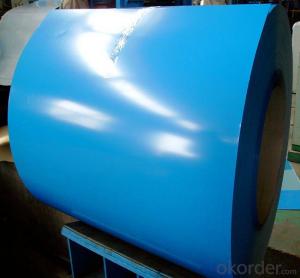Prepainted Aluminum Zinc rolled Coil for Construction
- Loading Port:
- Shanghai
- Payment Terms:
- TT OR LC
- Min Order Qty:
- 25 m.t.
- Supply Capability:
- 30000 m.t./month
OKorder Service Pledge
OKorder Financial Service
You Might Also Like
Structure of Aluminum Zinc Rolled Coil

Description of Aluminum Zinc Rolled Coil
Aluminum zinc coils is a kind of coated steel coil/sheet. With the cold rolled steel of different strength and thickness as substrate, it is produced through applying Al-Zn coat on both faces by hot dip process. In its coating, Al accounts for about 55%, Si 1.6%, while the remaining is Zn. Aluminum zinc coils enjoys both the physical protective feature and durability of Al and the electrochemical protective property of Zn. And its surface has bright silver color and regular embossed-like figure, which are highly decorative.
Main Feature of Aluminum Zinc Rolled Coil for Construction Roof
1.Corrosion resistance: It mainly depends on the aluminum protection. When the zinc being worn, the aluminum will form a dense layer of aluminum oxide, resist corrosion material to prevent further corrosion inside.
2. Heat resistance: Aluminum zinc alloy steel sheet has excellent heat resistance, can withstand high temperatures over 300 centigrade, and is similar with aluminized steel high temperature oxidation resistance. It often used in chimney pipes, ovens, fluorescent lighting device and the device cover.
3. Heat reflective: Galvanized steel plate heat-reflective high rate is twice as galvanized steel, often used to make insulation materials.
4. Economy: Because density of 55% AL-Zn is smaller than the density of Zn, so in the same weight and thickness of Galvanized zinc layer, aluminum-zinc steel plate is larger area more than 3% of galvanized steel sheet.
Applications of Aluminum Zinc Rolled Coil for Construction Roof
1. Construction and building: roofing; ventilating duct; handrail; partition panel;etc.
2. Electric appliance: refrigerator; washing machine; refrigerator; DVD;etc.
3.Transportation: oil tank; road sign; etc.
4.Agriculture:barn; etc.
5.Others:vending machine; game machine; etc.
Specifications of Prepainted Aluminum Zinc Rolled Coil for Construction
Product | Hot Dipped Galvanized Steel Coil / Galvalume /Aluzinc Steel coil |
Material Grade | SGCC / SGCH / DX51D+AZ, etc |
Thickness | 0.2-3.0mm |
Width | 600-1500mm |
Tolerance | Thickness: +/-0.02mm , Width:+/-2mm |
Zinc-coating | AZ40-150g/m2 |
Technique | Raw material: Hot rolled steel coil --> Cold rolled_>hot dipped galvalume |
Surface | Dried, Chromated, Unoiled |
Spangle | Regular spangle , small spangle, zero spangle |
ID | 508MM |
Coil weight | 3-6 tons |
Export package | Cardboard inner sleeves, Waterproof paper, galvanized steel covered and steel strip packed |
FAQ of Prepainted Aluminum Zinc Rolled Coil for Construction
We have organized several common questions for our clients,may help you sincerely:
1. What is the minimum order quantity ?
Our MOQ is 50mt for each size. And we will consider to give more discount if you make big order like 1000 tons and more. Further more, the more appropriate payment term your offer the better price we can provide.
2. How long can we receive the product after purchase?
Usually within thirty working days after receiving buyer’s advance payment or LC. We will arrange the factory manufacturing as soon as possible. The cargo readiness usually takes 15-25 days, but the shipment will depend on the vessel situation.
3. How to guarantee the quality of the products?
We have established the international advanced quality management system,every link from raw material to final product we have strict quality test;We resolutely put an end to unqualified products flowing into the market. At the same time, we will provide necessary follow-up service assurance.
- Q: What are the safety precautions when working with steel coils?
- When working with steel coils, it is important to follow several safety precautions. Firstly, workers should always wear the appropriate personal protective equipment (PPE) such as safety glasses, gloves, and steel-toed boots to protect themselves from potential hazards. Additionally, it is crucial to ensure that the work area is clean and free from any debris or obstacles that may cause accidents or tripping. Proper manual lifting techniques should be employed to avoid strain or injury when handling heavy steel coils. Workers should also be trained in the proper use of equipment such as cranes or forklifts to safely transport and store the coils. Regular inspections of equipment and proper maintenance should be conducted to prevent any malfunctions or accidents. Lastly, employees should be aware of emergency procedures and have access to fire extinguishers and first aid kits in case of any unexpected incidents. Overall, prioritizing safety measures and being vigilant can greatly minimize the risks associated with working with steel coils.
- Q: So i downloaded Broken Steel DLC for Fallout 3 for the 360. My guy is on the level where you have to activate the purifier and when i beat it. It was the normal ending that brought me back to the main menu. My friend said you have to find some guy to talk to but i don't think thats it. Please Help. P.S. i never got and conformation in-game about the download but its under the download sub menu at the main menu.
- Try Redownloading BS, That should work.
- Q: How are steel coils processed for heat treatment?
- Steel coils are typically processed for heat treatment by first being cleaned and prepped to remove any contaminants. They are then heated to a specific temperature and held at that temperature for a predetermined amount of time. After the desired heat treatment process is completed, the coils are cooled down gradually to ensure they retain the desired properties.
- Q: I have a white gold engagement ring, and to be special I thought I'd get a plain band from Tiffany's--in stainless steel. Can stainless steel be worn with white gold or will there be a difference in the color or texture? I'm not planning on getting them soldered together, but I don't want it to be noticeable that they are different metals. Does anyone have experience in this subject?
- Stainless steel is not going to look like white gold. I have some stainless steel pieces from Tiffany (not rings, just earrings and necklaces) and I think they look like.. well, stainless steel. They need to be polished often, and they scratch easily. Thats one thing when youre talking about earrings that just dangle from your ears, but honestly for a ring you are wearing on your hand... I would not go the stainless steel route. I would invest in a better metal that is going to stand the test of time.
- Q: How are steel coils cut to size?
- Steel coils are cut to size using a variety of methods such as shearing, slitting, or laser cutting. These processes involve using specialized machinery to ensure precise and accurate cuts according to the required dimensions.
- Q: I juuuust got a new stainless steel sink only 5 months ago, and it already has a couple rust spots on it.What caused this?!
- Stainless Steel is the marketing name. For truth in advertising, it should be called Stain Resistant Steel. It should be easy to scrub rust away with an SOS or Brillo pad. To prevent rust from recurring: * thoroughly rinse all chloride containing soaps away * scour the sink at least weekly to remove any residues * if the water source has high mineral content—especially iron—more frequent sink scouring is needed, plus towel drying the sink. * don't allow salt to remain in the sink—rinse it out
- Q: How are steel coils inspected for elongation?
- Elongation inspections of steel coils involve various methods. One commonly used technique entails employing a tensile testing machine. This method entails extracting a small sample from the steel coil and inserting it into the machine. Subsequently, the machine exerts a pulling force on the sample until it fractures. The force required to cause the sample to break is measured, and this data is utilized to determine the elongation of the steel coil. Ultrasonic testing represents another approach adopted to inspect steel coils for elongation. In this method, high-frequency sound waves are transmitted through the steel coil. Through the analysis of the sound wave reflections, it becomes feasible to ascertain the elongation and other characteristics of the steel coil. Visual inspection also holds significant importance in the examination of steel coils for elongation. Trained technicians visually scrutinize the steel coils for any indications of stretching or deformation, which may indicate excessive elongation. In conclusion, a comprehensive inspection of steel coils for elongation and adherence to industry standards entails a combination of mechanical testing, ultrasonic testing, and visual inspection. This approach ensures the quality and compliance of the steel coils.
- Q: can you play one?
- i play acoustic, but i have tried to play a steel guitar before, my cousin has one. (:
- Q: What are the different types of steel coil finishing processes?
- Enhancing the appearance and properties of steel coils involves employing various steel coil finishing processes. Among the commonly used processes are: 1. Hot-dip galvanizing: Immersing the steel coil in molten zinc forms a protective layer on its surface, enhancing corrosion resistance and providing a visually pleasing finish. 2. Cold rolling: Passing the steel coil through rollers at room temperature reduces thickness and improves surface finish. This process can yield finishes ranging from matte to highly polished. 3. Electro-galvanizing: A thin layer of zinc is electrolytically deposited onto the steel coil's surface. This method is suitable for applications requiring a thinner zinc coating and a more uniform finish. 4. Pickling and oiling: Treating the steel coil with an acid solution removes scale and impurities, resulting in a clean and smooth surface. Coating the coil with oil prevents rust during storage and transportation. 5. Powder coating: Dry powder is applied to the steel coil and cured under heat to form a durable and attractive finish. This method allows for a wide range of colors and finishes. 6. Paint coating: Similar to powder coating, liquid paint is applied to the steel coil's surface. This process offers decorative finishes and protection against corrosion and environmental factors. These examples represent only a few of the available steel coil finishing processes. The choice of method depends on specific application requirements, including desired appearance, corrosion resistance, and durability.
- Q: Are steel coils used in agricultural equipment manufacturing?
- Yes, steel coils are commonly used in agricultural equipment manufacturing. Steel coils are used to create various components such as frames, brackets, and supports, which are essential for the construction and durability of agricultural equipment. The strength and versatility of steel make it a preferred material choice for manufacturing agricultural machinery.
Send your message to us
Prepainted Aluminum Zinc rolled Coil for Construction
- Loading Port:
- Shanghai
- Payment Terms:
- TT OR LC
- Min Order Qty:
- 25 m.t.
- Supply Capability:
- 30000 m.t./month
OKorder Service Pledge
OKorder Financial Service
Similar products
Hot products
Hot Searches
Related keywords



